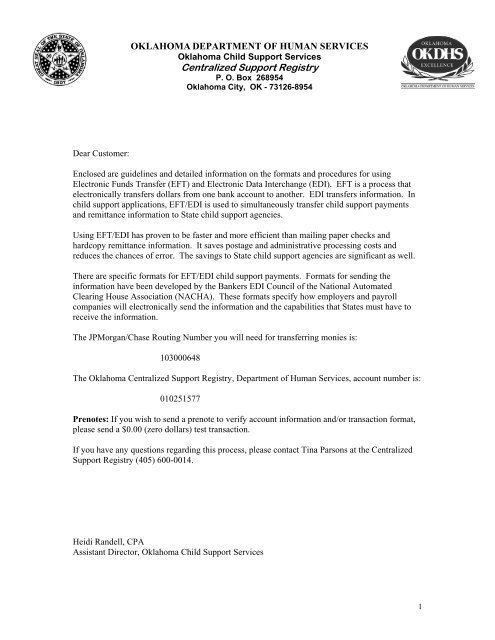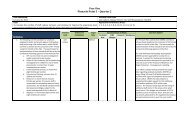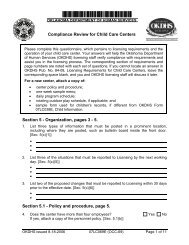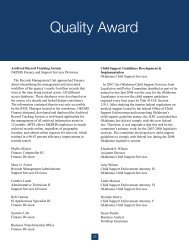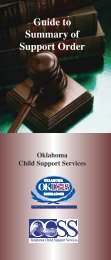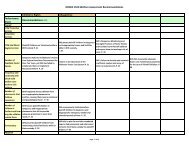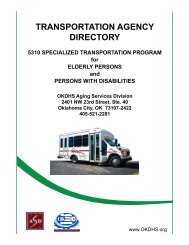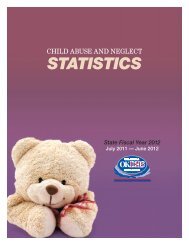Electronic Funds Transfer Packet - Oklahoma Department of Human ...
Electronic Funds Transfer Packet - Oklahoma Department of Human ...
Electronic Funds Transfer Packet - Oklahoma Department of Human ...
Create successful ePaper yourself
Turn your PDF publications into a flip-book with our unique Google optimized e-Paper software.
OKLAHOMA DEPARTMENT OF HUMAN SERVICES<br />
<strong>Oklahoma</strong> Child Support Services<br />
Centralized Support Registry<br />
P. O. Box 268954<br />
<strong>Oklahoma</strong> City, OK - 73126-8954 <br />
Dear Customer:<br />
Enclosed are guidelines and detailed information on the formats and procedures for using<br />
<strong>Electronic</strong> <strong>Funds</strong> <strong>Transfer</strong> (EFT) and <strong>Electronic</strong> Data Interchange (EDI). EFT is a process that<br />
electronically transfers dollars from one bank account to another. EDI transfers information. In<br />
child support applications, EFT/EDI is used to simultaneously transfer child support payments<br />
and remittance information to State child support agencies.<br />
Using EFT/EDI has proven to be faster and more efficient than mailing paper checks and<br />
hardcopy remittance information. It saves postage and administrative processing costs and<br />
reduces the chances <strong>of</strong> error. The savings to State child support agencies are significant as well.<br />
There are specific formats for EFT/EDI child support payments. Formats for sending the<br />
information have been developed by the Bankers EDI Council <strong>of</strong> the National Automated<br />
Clearing House Association (NACHA). These formats specify how employers and payroll<br />
companies will electronically send the information and the capabilities that States must have to<br />
receive the information.<br />
The JPMorgan/Chase Routing Number you will need for transferring monies is:<br />
103000648<br />
The <strong>Oklahoma</strong> Centralized Support Registry, <strong>Department</strong> <strong>of</strong> <strong>Human</strong> Services, account number is:<br />
010251577<br />
Prenotes: If you wish to send a prenote to verify account information and/or transaction format,<br />
please send a $0.00 (zero dollars) test transaction.<br />
If you have any questions regarding this process, please contact Tina Parsons at the Centralized<br />
Support Registry (405) 600-0014.<br />
Heidi Randell, CPA<br />
Assistant Director, <strong>Oklahoma</strong> Child Support Services<br />
1
OKLAHOMA DEPARTMENT OF HUMAN SERVICES<br />
<strong>Oklahoma</strong> Child Support Services<br />
Centralized Support Registry<br />
P. O. Box 268954<br />
<strong>Oklahoma</strong> City, OK - 73126-8954 <br />
EFT ADJUSTMENT POLICY <br />
OKLAHOMA CHILD SUPPORT SERVICES <br />
<strong>Oklahoma</strong> Child Support Services (OCSS) sometimes amends or releases the payroll deductions<br />
from a responsible parent’s wages. In some cases, the adjustment cannot be processed in time to<br />
affect the change on the next <strong>Electronic</strong> <strong>Funds</strong> <strong>Transfer</strong> (EFT).<br />
When adjustments cannot be processed in time, we request that you do not take any actions to<br />
correct the amount deducted. Please do not refund any money to the employee, or make<br />
adjustments to subsequent EFT payments. Often, CSED has made the necessary adjustments and,<br />
in some cases, money has been refunded to the employee. If an employee has questions about the<br />
amount deducted, please refer them to their CSED field <strong>of</strong>fice.<br />
In the event that money has been sent EFT to CSED in error please call the Centralized Support<br />
Registry at (405) 600-0014.<br />
2
The information in this guide is to provide employers and their financial institutions with the<br />
current formats, definitions and implementation recommendations to electronically remit child<br />
support payments and payment information through the ACH Network according to the<br />
conventions and standards supported by the banking and child support enforcement communities.<br />
This method speeds up the withholding process and allows the employer and child support entity<br />
to realize the numerous benefits <strong>of</strong> electronic data interchange (EDI) and electronic funds transfer<br />
(EFT).<br />
Frequently Asked Questions<br />
Q: How will EFT improve things?<br />
A: The process will reduce costs for you as an employer by minimizing the manual labor<br />
involved in preparing checks. If you currently use a payroll service, the service provider may be<br />
able to implement EFT with little or no additional cost. EFT will also reduce mail handling and<br />
check processing costs to State child support agencies. Finally, children will receive their child<br />
support much faster.<br />
Q: I have a small payroll and it is easier for me to mail in withheld child support payments. Why<br />
do I have to use EFT/EDI?<br />
A: You are not required to use EFT/EDI. You may continue mailing child support payments as<br />
you do now.<br />
Q: What are the timeframes required for me as an employer to process EFT payments?<br />
A: As a general rule, payments for child support should be remitted no later than seven business<br />
days after they have been deducted from the employee’s paycheck. Check with your State child<br />
support enforcement agency for specific timeframes.<br />
Q: Will there be assistance provided to employers for <strong>Electronic</strong> Data Interchange and problems<br />
that may arise?<br />
A: Yes. Contact the child support agency receiving the payments or the National Automated<br />
Clearing House Association at (703) 561-1100.<br />
Q: How can I get additional information about the electronic formats <strong>of</strong> files?<br />
A: Additional information can be obtained through your State child support <strong>of</strong>fice or through the<br />
National Automated Clearing House Association at (703) 561-1100 or view the website at<br />
www.nacha.org.<br />
3
How to Send <strong>Electronic</strong> Payments For Child Support<br />
There are several ways to send a child support payment electronically:<br />
• Through the banking system with electronic funds transfer/electronic data interchange (EFT/EDI),<br />
using the standard child support addendum record,<br />
• Through your state’s web-based payment service (now available in FL, IN, MI, NE, and WA—contact<br />
your state child support enforcement agency),<br />
• By using a major payroll service processor who is already sending child support payments<br />
electronically, or<br />
• By using a commercial vendor <strong>of</strong>fering web-based payment services to employers.<br />
EFT/EDI QUICK AND EASY CHILD SUPPORT PAYMENTS<br />
*****3-STEP PROCESS FOR EMPLOYERS*****<br />
Listed below are three steps employers can take to use EFT/EDI for remitting child support payments<br />
more quickly and easily.<br />
Step 1:<br />
Determine whether your payroll/accounting system supports electronic payments<br />
for child support. If it does not:<br />
• In-house information technology (IT) staff may be able to make programming changes in order to<br />
produce electronic payments for child support (including the EDI DED child support addendum record<br />
that states need in order to identify the payment).<br />
• Your payroll/accounting s<strong>of</strong>tware developer may have an enhancement that supports electronic<br />
payments for child support. Contact your users’ group or s<strong>of</strong>tware representative.<br />
• Your bank probably has a s<strong>of</strong>tware package that will enable you to produce the file formats necessary<br />
for electronic payments. Contact someone in “cash management” or “Treasury services” at your bank.<br />
Step 2:<br />
Contact the appropriate state child support enforcement agency.<br />
• This may not always be the child support enforcement agency that originally issued the<br />
income withholding. Usually you should contact the state disbursement unit (SDU) to which<br />
you send child support payments.<br />
• Find out the EFT/EDI start-up procedures for the state to which you intend to send the e-<br />
payment. Please do not transmit child support withholdings electronically without that<br />
information.<br />
4
Step 3:<br />
Conduct the EFT/EDI start-up procedures for each state to which you send child<br />
support income withholdings. These typically include:<br />
• An exchange <strong>of</strong> basic banking information, bank routing codes, bank account numbers, and<br />
Federal Information Processing Standards (FIPS) code information with the state child<br />
support enforcement agency.<br />
• A reconciliation between state records and employer records <strong>of</strong> Social Security numbers and<br />
case identification numbers so that each employee’s withholding is properly credited.<br />
• A transmission <strong>of</strong> an initial test file, or pre-note, to ensure that the automated clearinghouse<br />
(ACH) records are formatted and transmitted properly.<br />
• States are required to receive child support payments in two formats: CCD+ or the CTX 820<br />
Remittance format. Make sure you are using one <strong>of</strong> these two standard NACHAapproved<br />
formats.<br />
5
State <strong>of</strong> <strong>Oklahoma</strong><br />
A Guide for Employers <br />
& <br />
Financial Institutions <br />
EFT/EDI <br />
6
NACHA Record Formats<br />
The rules and guidelines governing the formats, specifications and exchange <strong>of</strong> ACH entries are<br />
published by NACHA. With respect to the data that are contained in the Addenda Records <strong>of</strong><br />
ACH formats, the NACHA Operating Rules stipulate the type <strong>of</strong> data that may be exchanged as<br />
well as which standards and formats are permitted, but the structure <strong>of</strong> the data contents is<br />
managed outside <strong>of</strong> the NACHA rules.<br />
For example, the NACHA Operating Rules permit the exchange <strong>of</strong> NACHA-endorsed banking<br />
conventions within the Addenda Record <strong>of</strong> the CCD+ format, but groups such as the Bankers<br />
EDI Council develop and maintain banking conventions. Also, the rules permit the exchange <strong>of</strong><br />
certain EDI messages or transaction sets (e.g., 820 Payment Order/Remittance Advice) within the<br />
Addenda Records <strong>of</strong> the CTX format and Xl2 syntax-based data segments within the Addenda<br />
Records <strong>of</strong> the CCD+ and PPD+ formats, but those standards are developed and maintained by<br />
other standards development organizations, such as ASC Xl2 and UN/EDIFACT.<br />
The following record formats are used to convey entries through the ACH Network:<br />
• File Header Record<br />
• Company/Batch Header Record<br />
• Entry Detail Record<br />
• Addenda Record<br />
• Company/Batch Control Record<br />
• File Control Record<br />
An ACH file is bounded by one File Header Record and one File Control Record, which serve to<br />
facilitate transmission, identification and balancing <strong>of</strong> the file. A file may be comprised <strong>of</strong> one or<br />
more batches, which are denoted by the Company/Batch Header Record and Company/Batch<br />
Control Record. These records contain information specific to all <strong>of</strong> the Entry Detail Records<br />
contained within that batch. A batch may house one or more Entry Detail Records that share<br />
certain aspects as explained in the NACHA Operating Rules. The Entry Detail Record is the<br />
record that constitutes the payment order and is used within the banking system to execute EFT<br />
and settlement. An Addenda Record is used to supply additional information related to the<br />
7
payment issued in the Entry Detail Record. Each Addenda Record Includes an 80 position<br />
Payment Related information Field within which this remittance detail is transmitted.<br />
The CCD and CTX payment formats are used within the ACH Network to conduct the transfer <strong>of</strong><br />
funds between business or government entities. To exchange data along with payments using EDI<br />
technology, Addenda Records are used. Under the NACHA Operating Rules, a CCD format<br />
maybe accompanied by only one Addenda Record, which may carry X12 data segments or<br />
elements or NACHA-endorsed banking conventions. A CCD entry accompanied by an Addenda<br />
Record is referred to as a CCD+. The CTX format allows for the provision <strong>of</strong> 9,999 Addenda<br />
Records, which may be used to carry certain Xl2 transaction sets or UN/EDIFACT messages in<br />
their entirety<br />
The NACHA record formats for CCD+ entries flow in the following order:<br />
File Header Record<br />
Company/Batch Header Record<br />
Entry Detail Record<br />
Addenda Record (1 addenda with 80 byte Payment Related Information<br />
Field)<br />
Entry Detail Record<br />
Addenda Record (1 addenda with 80 byte Payment Related Information<br />
Field)<br />
Entry Detail Record<br />
Addenda Record (1 addenda with 80 byte Payment Related Information<br />
Field)<br />
Entry Detail Record<br />
Addenda Record (1 addenda with 80 byte Payment Related Information<br />
Field)<br />
Company/Batch Control Record<br />
File Control Record<br />
The NACHA record formats for CTX entries flow in the following order:<br />
File Header Record<br />
Company/Batch Header Record<br />
Entry Detail Record<br />
Addenda Record (up to 9,999 addenda with 80 byte Payment Related<br />
Information Field)<br />
Addenda Record<br />
Addenda Record<br />
Addenda Record<br />
Addenda Record<br />
Entry Detail Record<br />
Addenda Record (up to 9,999 addenda with 80 byte Payment Related<br />
Information Field)<br />
Addenda Record<br />
Addenda Record<br />
Addenda Record<br />
Addenda Record<br />
Addenda Record Company/Batch Control Record<br />
8
File Control Record<br />
Following are the layouts for the NACHA Entry Detail and Addenda Records used with the<br />
CCD+ And CTX formats. To obtain a full citation <strong>of</strong> the rules, specifications and formats for the<br />
ACH Network, refer to the NACHA Operating Rules.<br />
9
CCD ENTRY DETAIL RECORD<br />
2.1.4 Sequence <strong>of</strong> Records for CCD Entries<br />
ENTRY DETAIL RECORD<br />
FIELD 1 2 3 4 5 6 7 8 9 10 11<br />
DATA RECORD TRANSACTION RECEIVING DFI CHECK DFI ACCOUNT AMOUNT IDENTIFICATION RECEIVING DISCRETIONARY ADDENDA RECORD TRACE<br />
ELEMENT TYPE CODE IDENTIFICATION DIGIT NUMBER NUMBER COMPANY NAME DATA INDICATOR NUMBER<br />
NAME<br />
CODE<br />
Field M M M M R M O R O M M<br />
Inclusion<br />
Requirement<br />
Contents ‘6’ Numeric TTTTAAAA Numeric Alphameric $$$$$$$$cc Alphameric Alphameric Alphameric Numeric Numeric<br />
Length 1 2 8 1 17 10 15 22 2 1 15<br />
Position 01-01 02-03 04-11 12-12 13-29 30-39 40-54 55-76 77-78 79-79 80-94<br />
CTX ENTRY DETAIL RECORD<br />
2.1.6 Sequence <strong>of</strong> Records for CTX Entries<br />
CORPORATE ENTRY DETAIL RECORD<br />
FIELD 1 2 3 4 5 6 7 8 9 10 11 12 13<br />
DATA RECORD TYPE TRANSACTION RECEIVING DFI CHECK DFI ACCOUNT AMOUNT IDENTIFICATION NUMBER RECEIVING RESERVED DISCRETIONARY ADDENDA TRACE<br />
ELEMENT CODE CODE IDENTIFICATION DIGIT NUMBER NUMBER OF COMPANY DATA RECORD NUMBER<br />
NAME ADDENDA NUMBER INDICATOR<br />
RECORDS<br />
Field<br />
Inclusion<br />
Requirement<br />
M M M M R M O M R N/A O M M<br />
Contents ‘6’ Numeric TTTTAAAA Numeric Alphameric $$$$$$$$cc Alphameric Numeric Alphameric Blank Alphameric Numeric Numeric<br />
Length 1 2 8 1 17 10 15 4 16 2 2 1 15<br />
Position 01-01 02-03 04-11 12-12 13-29 30-39 40-54 55-58 59-74 75-76 77-78 79-79 80-94<br />
ADDENDA RECORD<br />
ADDENDA RECORD<br />
FIELD 1 2 3 4 5<br />
DATA<br />
ELEMENT<br />
NAME<br />
RECORD<br />
TYPE CODE<br />
ADDENDA<br />
TYPE CODE<br />
PAYMENT RELATED<br />
INFORMATION<br />
ADDENDA<br />
SEQUENCE NUMBER<br />
ENTRY DETAIL<br />
SEQUENCE NUMBER<br />
Field<br />
Inclusion<br />
Requirement M M O M M<br />
Contents<br />
‘7’ ‘05’ Alphameric Numeric Numeric<br />
Length 1 2 80 4 7<br />
Position 01-01 02-03 04-83 84-87 88-94<br />
10
Child Support Application Banking Convention<br />
Within the 80 position Payment Related Information Field <strong>of</strong> the CCD+ Addenda Record,<br />
remittance information corresponding to the child support payment made by an employer to a<br />
child support enforcement entity is presented in the following banking convention. This<br />
convention is referred to as the 'DED' Deduction data segment under ASC X12 syntax and is<br />
composed <strong>of</strong>ten fields:<br />
• Segment Identifier<br />
• Application Identifier<br />
• Case Identifier<br />
• Pay Date<br />
• Payment Amount<br />
• Non-Custodial Parent Social Security Number<br />
• Medical Support Indicator<br />
• Non-Custodial Parent Name<br />
• FIPS Code<br />
• Employment Termination Indicator<br />
Each <strong>of</strong> these fields is referred to as a data element, which is the smallest named item in a record<br />
It can represent a qualifier, a value, or text. A data element has three primary attributes - length,<br />
field requirement, and type. Each data element is identified by an element identifier used for<br />
reference (e.g., DED01, DED02, etc.) and each element has a specific position within the record<br />
(segment). In constructing the segment, each data element (except for the first) is preceded by the<br />
separator character. In the ACH Network, the data element separator is an asterisk ('*'). Each<br />
segment must end with a terminator, which in the ACH Network is a backslash ('\ ')<br />
The following is an example <strong>of</strong> the DED segment as used in the Payment Related Information<br />
field <strong>of</strong> the Addenda Record:<br />
DED*application identifier*case identifier*pay date*payment amount*noncustodial<br />
parent ssn*medical support indicator*non-custodial parent name*FIPS<br />
code*employment termination indicator\<br />
Note the use <strong>of</strong> the asterisk ('*') and backslash ('\')<br />
Data elements in a segment are either mandatory or optional. Data elements in a segment that are<br />
not mandatory as defined by the standard may be omitted. The omission <strong>of</strong> an optional element is<br />
noted by the placement <strong>of</strong> an asterisk in the place <strong>of</strong> that element. For example, if non-custodial<br />
parent name were to be omitted from the segment, it would look like this:<br />
DED*application identifier*case identifier*pay date*payment <br />
amount*non-custodial parent ssn*medical support indicator FIPS <br />
code*employment termination indicator\ <br />
11
Also, if an optional data element is the last data element in a segment, and that field is not being<br />
used, the preceding asterisk is replaced by the backslash. For example, if the employment<br />
termination indicator is omitted from the segment, it would look like this:<br />
DED*application identifier*case identifier*pay date*payment amount*noncustodial<br />
parent ssn*medical support indicator*non-custodial parent name*FIPS<br />
code\<br />
The following grid delineates the format for the DED Segment (Convention) for employers:<br />
DED CHILD SUPPORT SEGMENT/CONVENTION FOR EMPLOYERS<br />
Element Comments Content Attributes<br />
1 2 3<br />
Segment Identifier DED M ID 3/3<br />
DED01 Application Identifier CS M ID 2/2<br />
DED02 Case Identifier XXXXXXXXX M ID 1/20<br />
DED03 Pay Date YYMMDD M AN 6/6<br />
DED04 Payment Amount $$$$$$$$CC M DT 1/10<br />
DED05<br />
Non-Custodial Parent Social Security<br />
Number<br />
XXXXXXXXX M N2 9/9<br />
DED06 Medical Support Indicator 'Y' -Yes, 'N' ,. No M AN 1/1<br />
DED07 Non-Custodial Parent Care XXXXXXXXXX O AN 1/10<br />
DED08 FIPS Code XXXXXXX O AN 5/7<br />
DED09 Employment Termination Indicator 'Y' -Yes O AN 1/1<br />
12
Sample DED Segment<br />
DED*CS*ZC146*951024*13547*975348431*N*SMITH,HARR*A4738*Y\<br />
(Reminder: due to the one-addenda limitation <strong>of</strong> the CCD+ format, the DED segment is restricted<br />
to a maximum <strong>of</strong> 80 characters. Note the use <strong>of</strong> the asterisk and backslash.)<br />
The column headings used on the grid are as follows:<br />
• Element defines the data element name<br />
• Comments and Content define the data element<br />
• Attributes are defined as follows<br />
1. Field Requirement - The first column <strong>of</strong> the attributes is the field requirement for that data<br />
element. An 'M' denotes a mandatory element, an 'O' denotes an optional element<br />
2. Data Type -The second column <strong>of</strong> the attributes specifies the field data type.<br />
'AN' denotes a string type data element. Contents <strong>of</strong> string data elements are a sequence <strong>of</strong><br />
letters, digits, spaces and/or special characters (with the exception <strong>of</strong> the asterisk and<br />
backslash). The contents must be left-justified. Trailing spaces should be suppressed unless<br />
they are necessary to satisfy a minimum length requirement<br />
'DT' denotes a date type data element. Format for the date is YYMMDD. YY is the last two<br />
digits <strong>of</strong> the year (00-99), MM is the numeric value <strong>of</strong> the month (1-12), and DD is the<br />
numeric value <strong>of</strong> the day (1-31)<br />
'ID' denotes an identifier data element from a pre-defined list <strong>of</strong> values<br />
'N2' denotes a numeric type data element with two decimal places to the right <strong>of</strong> a fixed,<br />
implied decimal point. The decimal point is not transmitted. It is intended that this number<br />
will always be positive for the child support application banking convention. For example,<br />
the amount $135.47 would appear as *13547<br />
3<br />
Length -The third column <strong>of</strong> the attributes signifies the minimum/maximum use <strong>of</strong> an<br />
element.This specifies the minimum and maximum length <strong>of</strong> a particular field. For example,<br />
1/6 indicates that this data element must be at least one character, but not more than six.<br />
13
ELEMENT DEFINITIONS<br />
DED0l Application Identifier: Supported Code Value -'CS' -Child Support<br />
The application identifier indicates the type <strong>of</strong> deduction being withheld from an employee's pay<br />
DED02<br />
Case Identifier:<br />
The case identifier element is the IV-D case number or court order number. The case identifier<br />
always refers to the identification number <strong>of</strong> the case in the state receiving the EFT/EDI<br />
transaction (e.g., the child support receiving agency). This is true whether the transaction is from<br />
an employer or another state. The child support receiving agency determines which number to use<br />
DED03<br />
Pay Date:<br />
The pay date element provides the obligor's (non-custodial parent) pay date or the date <strong>of</strong> income<br />
withholding (i.e., the date the funds were withheld by the employer)<br />
DED04<br />
Payment Amount:<br />
The payment amount element indicates the non-custodial parent's withholding amount for this<br />
pay period being paid to the child support receiving agency<br />
DED05<br />
Non-Custodial Parent Social Security Number:<br />
The non-custodial parent Social Security Number element provides the child support receiving<br />
agency with the non-custodial parent's Social Security Number<br />
DED06 Medical Support Indicator: Supported Code Values -'Y', 'N'<br />
The medical support indicator indicates whether the non-custodial parent has family medical<br />
insurance coverage available through his/her employer. If medical insurance coverage is available<br />
through his/her employer, a 'Y' is used; if there is no coverage available, an 'N' is used<br />
DED07<br />
Non-Custodial Parent Name:<br />
The non-custodial parent name element indicates the first seven letters <strong>of</strong> the obligor's last name<br />
followed by at least the first three letters <strong>of</strong> his/her first name. A comma must be used to separate<br />
the last name from the first name <strong>of</strong> the non-custodial parent when the last name is less than<br />
seven characters.<br />
DED08<br />
FIPS Code:<br />
The Federal Information Process Standard (FIPS) code refers to the FIPS Code <strong>of</strong> the child<br />
support entity receiving the transaction. It is five characters when indicating both the state and<br />
county codes. It is seven characters when indicating state, county, and local codes.<br />
DED09 Employment Termination Indicator: Supported Code Value –‘Y'<br />
The employment termination indicator is used to notify the child support enforcement agency that<br />
an individual's employment has terminated. A 'Y' is placed in this field if the employee has<br />
terminated; otherwise the field is not used. The payment amount field may contain zero when this<br />
field is used.<br />
14
CTX Format & ASC X12 820 Payment Order/ Remittance Advice<br />
At a minimum, state child support entities are required to accept employer originated child<br />
support withholding payments sent in the NACHA CCD+ format by October 1, 1997. Many<br />
states already have this capability. An increasing number <strong>of</strong> states also accept these payments<br />
made using the CTX format containing the ASC X12 820 transaction set. As indicated<br />
previously, the CTX format may have up to 9,999 Addenda Records associated with each Entry<br />
Detail Record, thus greatly expanding the reporting potential. Going forward, the number <strong>of</strong> child<br />
support entities supporting the CTX/820 option will rise; therefore, an employer should check<br />
with the receiving child support enforcement entity to determine if it can receive and process the<br />
CTX/820. The employer should contact its financial institution to verify input options as well as<br />
the institution's ability to originate a CTX format.<br />
The Addenda Record <strong>of</strong> the CTX format containing the ASC X12 820 transaction set used to<br />
send child support payments would typically be comprised <strong>of</strong> the following data segments:<br />
ISA<br />
Interchange Control Header: (mandatory)<br />
A control segment used to start and identify an interchange <strong>of</strong> zero or more functional groups and<br />
interchange-related control segments<br />
GS Functional Group Header: (mandatory)<br />
Control segment used to indicate the beginning <strong>of</strong> a functional group and to provide control<br />
information.<br />
ST Transaction Set Header: (mandatory)<br />
Control segment used to indicate the start <strong>of</strong> a transaction set and to assign a control number (<br />
e.g., ST*820 selects the 820 transaction set).<br />
BPR<br />
Beginning Segment for Payment Order/Remittance Advice: (mandatory)<br />
Segment used to indicate the beginning <strong>of</strong> a Payment Order/Remittance Advice Transaction Set<br />
and total payment amount or to enable related transfer <strong>of</strong> funds and/or information from payer to<br />
payee to occur. This segment identifies the dollar value <strong>of</strong> the payment along with the bank<br />
routing information.<br />
TRN<br />
Trace: (optional)<br />
Segment used to uniquely identify a transaction to an application; identifies the transaction<br />
reference number.<br />
REF Reference Numbers: (optional)<br />
Segment used to specify identifying numbers; provides additional reference information.<br />
N1 Name: (optional)<br />
Segment used to identify a party by type <strong>of</strong> organization, name and code; provides name<br />
information.<br />
ENT<br />
Entity: (optional)<br />
15
Segment used to designate the entities which are parties to a transaction and specify a reference<br />
meaningful to those entities.<br />
DED Deduction: (mandatory)<br />
Segment used to specify payment information for child support payment deductions; provides the<br />
child support payment information (refer to DED segment grid); more than one DED segment<br />
may be conveyed in the transaction. The DED segment is optional within the 820 transaction set,<br />
but it must be used for the purpose <strong>of</strong> exchanging child support payments with payment<br />
information.<br />
SE Transaction Set Trailer: (mandatory)<br />
Control segment used to indicate the end <strong>of</strong> the transaction set and provide the count <strong>of</strong> the<br />
transmitted segments (including the beginning (ST) and ending (SE) segments)<br />
GE Functional Group Trailer: (mandatory)<br />
Control segment used to indicate the end <strong>of</strong> a functional group and to provide control information<br />
IEA<br />
Interchange Control Record: (mandatory)<br />
Control segment used to define the end <strong>of</strong> an interchange <strong>of</strong> one or more functional groups or<br />
interchange-related control segments, or a combination <strong>of</strong> functional groups and interchange<br />
control segments.<br />
The above summary <strong>of</strong> data segments used within the 820 transaction set do not specify the data<br />
elements used within each <strong>of</strong> the segments. The DED segment is the same as within the CCD+<br />
format Addenda Record; however, additional segments are used to construct the full 820<br />
transaction set and exchange it in an EDI environment. Please consult ASC X12 standards<br />
documentation and the 820 Implementation Guides published by the Bankers EDI Council for<br />
detailed standards and implementation information and instructions.<br />
Additional Information<br />
Employers and financial institutions needing additional information will find an array <strong>of</strong> available<br />
and valuable resources. First and foremost, employers are encouraged to contact their financial<br />
institutions to determine how to get started in EDI and EFT. NACHA and its family <strong>of</strong> local<br />
ACH Associations across the country can be <strong>of</strong> assistance in obtaining additional information and<br />
locating EDI capable financial institutions. The Data Interchange Standards Association (DISA),<br />
as the secretariat <strong>of</strong> ASC X12, is the primary source <strong>of</strong> X12 syntax standards. The American<br />
Payroll Association (APA) and Treasury Management Association (TMA) are also valuable<br />
sources <strong>of</strong> information. For information related to child support, employers are encouraged to<br />
contact the child support entities to which they are instructed to remit employee wages. Provided<br />
is a list <strong>of</strong> key contact telephone numbers:<br />
NACHA/Bankers EDI Council<br />
(703)742-9190<br />
American Payroll Association (212)686-0230<br />
Data Interchange Standards Association (DISA) (703)548- 7005<br />
Treasury Management Association (TMA) (301)907-2862<br />
16
Federal Government On-line Access<br />
The Administration for Children and Families (ACF) <strong>of</strong> the U.S. <strong>Department</strong> <strong>of</strong> Health and<br />
<strong>Human</strong> Services operates a computerized bulletin board service (ACF BBS) that can be accessed<br />
by users from across the country by calling a toll-free 800 number (1-800-627-8886) with a<br />
computer-based communications s<strong>of</strong>tware program. The ACF BBS is available 24 hours a day, 7<br />
days a week. By accessing the ACF BBS, users can:<br />
• leave messages and information requests for ACF staff<br />
• share ideas and information with users from across the country<br />
• download ACF fact sheets and press releases<br />
• download files <strong>of</strong> interest to the child support enforcement community<br />
The ACF BBS is a menu-driven system with on-screen, context-sensitive help available at the<br />
touch <strong>of</strong> a button. In addition, ACF BBS users may call the system operator (SYSOP) for help<br />
and to determine interface requirements at (202)401-5682.<br />
State Child Support Enforcement Offices<br />
Toll Free<br />
CSE Number<br />
Alabama 1(800)284-4347 (205)242-9300<br />
Alaska 1(800)478-3300 (907)269-6900<br />
Arizona 1(800)543-7383 (602)252-4045<br />
Arkansas 1(800)264-2445 (501)682-8398<br />
California 1(800)952-5253 (916)654-1532<br />
Colorado (303)866-5994<br />
Connecticut 1(800)228-KIDS (203)566-1830<br />
Delaware (302)577-4863<br />
Florida 1(800)622-KIDS (904)922-9590<br />
Georgia 1(800)227-7993 (404)657-3851<br />
Guam 011 (671)475-3360<br />
Hawaii (808)587-3698<br />
Idaho 1(800)356-9868 (208)334-5710<br />
Illinois 1(800)447-4278 (217)524-4602<br />
Indiana 1(800)622-4932 (317)232-4894<br />
Iowa (515)281-5580<br />
Kansas (913)296-3237<br />
Kentucky 1(800)248-1163 (502)564-2285<br />
Los Angeles (213)889-2991<br />
17
Toll Free<br />
CSE Number<br />
Louisiana 1(800)256-4650 (504)342-4780<br />
Maine 1(800)371-3101 (207)287-2886<br />
Maryland 1(800)332-6347 (410)767-7619<br />
Massachusetts 1(800)332-2733 (617)246-0774<br />
Michigan (517)373-7570<br />
Minnesota (612)296-2542<br />
Mississippi 1(800)345-6347 (601)359-4500<br />
Missouri 1(800)859-7999 (314)751-4301<br />
Montana 1(800)346-5437 (406)444-4614<br />
Nebraska 1(800)831-4573 (402)471-9103<br />
Nevada 1(800)992-0900 (702)687-4744<br />
New Hampshire (603)271-4426<br />
New Jersey 1(800)621-KIDS (609)588-2915<br />
New Mexico 1(800)432-6217 (505)827-7200<br />
New York 1(800)342-3009 (518)474-9081<br />
North Carolina 1(800)992-9457 (919)571-4114<br />
North Dakata 1(800)755-8530 (701)328-3582<br />
Ohio 1(800)686-1556 (614)752-6561<br />
<strong>Oklahoma</strong> 1(800)522-2922 (405)522-5871<br />
Oregon 1(800)850-0228 (503)373-1698<br />
Pennsylvania 1(800)932-0211 (717)787-3672<br />
Puerto Rico (809)722-4731<br />
Rhode Island 1(800)922-0536 (401)277-2847<br />
South Carolina 1(800)768-5858 (803)737-5870<br />
South Dakota (605)773-3641<br />
Tennessee 1(800)874-0530 (615)741-2441<br />
Texas 1(800)252-8014 (512)463-2181<br />
Utah 1(800)257-9156 (801)536-8500<br />
Vermont 1(800)786-3214 (802)241-2713<br />
Virgin Islands (809)774-5666<br />
Virginia 1(800)468-8894 (804)692-1428<br />
Washington 1(800)457-6202 (360)586-3162<br />
Washington, D.C. (202)724-8800<br />
West Virginia 1(800)634-4419 (304)558-3780<br />
Wisconsin (608)266-9909<br />
Wyoming 1(800)457-3659 (307)777-7631<br />
18


